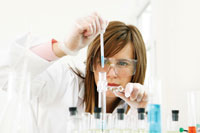
In Lewis Carroll’sThrough the Looking-Glass, the Red Queen said, “It takes all the running you can do, to keep in the same place.” That statement sums up how the food industry works today. It needs to perform more efficiently and economically and look beyond company walls for the tools and support to meet the demands of customers and an ever-changing marketplace.
Wal-Mart, for example, announced the adoption of the Global Food Safety Initiative (GFSI) standards requiring suppliers to complete initial certification between July and December of 2008 and full certification by July 2009. These certifications include SQF 2000 (Safe Quality Food) managed by the Food Marketing Institute, the Dutch HACCP Standard, BRC (British Retail Consortium) and IFS (International Food Standard) by Federal Union of German Trade Associations. All of these include a mandate for laboratory testing and analysis.
How do you determine which lab to use? Many companies have lists of approved labs that vendors must use. One criterion used is ISO 17025. This certification indicates the lab has established both a management system to ensure quality and has the technical capabilities to do the work. The management requirements focus on the documentation and efficacy of the quality management system. The technical requirements focus on competency of the laboratory staff, the use of recommended and/or official methods and the testing/calibration of the laboratory equipment and instruments.
However, is simply selecting a certified laboratory or a facility approved by your customers the best route? I have a colleague who operates a contract testing laboratory. He’s never felt certification was worth the investment, nor has he solicited large operations to become approved vendors. He was recently informed by several clients that their customers were requiring them to use another facility. But two weeks later, clients were calling their original laboratory with requests to explain the results given by the new lab.
ISO 17025 does not specifically state that a certified laboratory has to explain its results. However, Section 4.1.2 states, “It is the responsibility of the laboratory to carry out its testing and calibration activities in such a way as to meet the international standard and to satisfy the needs of the client.” Section 5.10.5 says: “When opinions and interpretations are included, the laboratory shall document the basis on upon which the opinions and interpretations have been made.”
This says two things:
• Food processors should treat laboratories like any other vendor. This includes criteria for reviewing the facility, conducting an audit of the facility and establishing acceptance criteria, and
• Establishing a contract with the lab that defines how results shall be reported and what information is required in those reports.
There are many food processors that do not have resources to perform the work in-house. They need help with microbiological, chemical and nutritional analyses. Some companies do not have technical staff to evaluate the reports. These operations need a laboratory to provide insights and guidance. But the help should be based on real experience, not textbook learning.
If you already have a good lab and are told by a client that you must change it, fight to keep that facility by asking your client to approve it. The lab should provide you with accurate reports listing methods, results, sample descriptions, product codes and any other requirements you have built into the contract, including analysis of data. It should also have experience working with your products and understand the processes used to manufacture them. After all, if you manufacture aseptic tomato paste, you don’t want the contract laboratory running coliforms and total plate counts.
Richard F. Stier,
Contributing Editor
